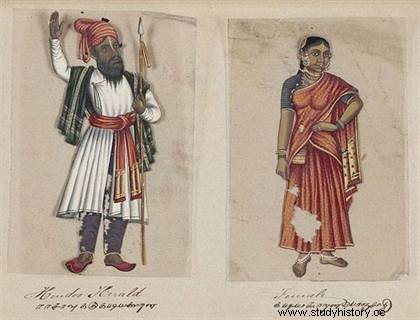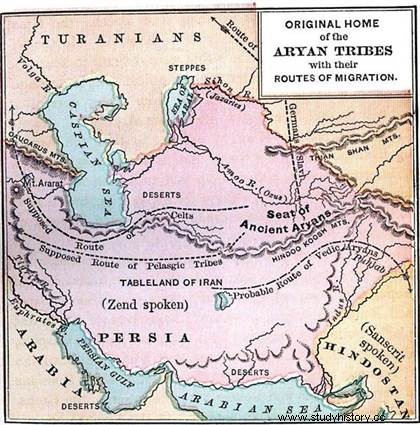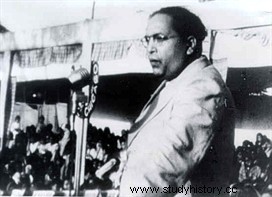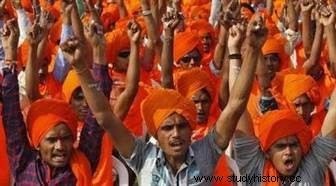 The Aryans were Indo-Europeans who settled at the end of the third millennium on the Iranian plateau and who, around 1500 BC. J.-C., began to penetrate into Punjab, where they founded Indian civilization, and gave themselves the name of ârya, which, in Sanskrit, means “excellent”, “honorable”, “noble”. During the 19th and 20th centuries, Europe went in search of its history, its origins, and became passionate about these mysterious Aryans. The Nazis in this fertile identity ground draw and amalgamate various pamphlets and scientific works to create an ideological corpus:the Aryan race takes a special place in European history.
The Aryans were Indo-Europeans who settled at the end of the third millennium on the Iranian plateau and who, around 1500 BC. J.-C., began to penetrate into Punjab, where they founded Indian civilization, and gave themselves the name of ârya, which, in Sanskrit, means “excellent”, “honorable”, “noble”. During the 19th and 20th centuries, Europe went in search of its history, its origins, and became passionate about these mysterious Aryans. The Nazis in this fertile identity ground draw and amalgamate various pamphlets and scientific works to create an ideological corpus:the Aryan race takes a special place in European history.
Aryans:origin(s) and definition(s)
In general, the term Aryans is reserved for the eastern peoples of the Indo-European family, who left in the Veda religious texts the purest monument of their original civilization . But in 1860, the orientalist Max Müller proposed to replace the already accepted terms of Indo-Europeans and Indo-Germans by the term of Aryans to designate the family of peoples, united by a certain linguistic kinship, from which descend the Indians, Persians, Greeks, Romans, Celts, Germans and Slavs.
Around the same time, the doctrine of Aryanism, affirming the superiority of the Aryans (in the general sense of Indo-Europeans) over all other known human groups, found its first expression in France in the famous Essay on the inequality of human races (1853-55) by Gobineau; Disseminated in Germany by L. Schemann's Gobineau Vereinigung (1894) and by the works of Houston Stewart Chamberlain, it was to contribute to the formation of the racist ideology of National Socialism.
Aryanity as seen by Europeans
 "Aryanity" was born with the works of William Jones. Founder of the Asiatic Society in Calcutta, he is at the origin with the Frenchman Anquetil-Duperron of the notion of an Indo-European family. Sanskrit gradually becomes the pure language that would have been used by the Aryans. Using a pure language, it was to be the origin of all Indo-European languages. The Aryans become the ancestors of the Europeans; Indo-Aryans and Indo-Europeans quickly merge.
"Aryanity" was born with the works of William Jones. Founder of the Asiatic Society in Calcutta, he is at the origin with the Frenchman Anquetil-Duperron of the notion of an Indo-European family. Sanskrit gradually becomes the pure language that would have been used by the Aryans. Using a pure language, it was to be the origin of all Indo-European languages. The Aryans become the ancestors of the Europeans; Indo-Aryans and Indo-Europeans quickly merge.
The Indo-European hypothesis is widely debated today (we refer to the work of Jean-Paul Demoule, But where are the Indo-Europeans? Myth of origin of the West). The Indo-Aryan concept was used as early as the 19th century as an instrument by rival colonial powers:Jyoti Mohan shows that French anthropologists insisted on Aryan greatness, as part of a struggle against British domination.
Paul Topinard, Louis Rousselet, Arthur Gobineau, and Gustave le Bon are major authors who have contributed to highlighting the Aryans and establishing a racial hierarchy in India. They can insist on a possible Aryan revival, motivated by the great mutiny of 1857 (the revolt of sepoy soldiers which threatened the power of the English East India Company). The Anglo-Saxons, although accepting the existence of an Aryan greatness, justify their conquests by insisting on its decline, the domination of the Dravidians in India and the "corruption" of the Aryan "race" with inferior races. German authors continue work on the subject and debate the origin of the Aryans and “Aryan purity”. Some locate their origin further west in Northern Europe or Germany. According to Leon Poliakov, Europe entered an “Aryan era” of which Nazism is only an heir.
The institutionalization of castes in India
Keshub Chandra Sen is an example of an Indian nationalist who considered himself a "cousin" of the English, largely steeped in British culture, a member of India's upper classes and castes . He thinks about the question of caste hegemony and links it to racial questions. It should be emphasized that while the caste system became more rigid during the British era with the censuses, the English did not invent it. This became institutionalized with British presuppositions and ideologies in dialogue with indigenous elites. Europe was also interested in castes. Gobineau wrote that castes were a reflection of Aryan "superiority." Max Müller, in addition to the division between two Asian or European Aryan races, develops the idea that the Aryans would have invaded India.
The idea then emerges that the dominant nomadic Aryas would have subjected the dasyu (future Dravidians) to more "matte" skin in India. The visible social divisions would find their origin in this invasion. If this theory serves the "colonized" elites of the upper castes, it could be used in particular by Christian missionaries like John Muir or John Wilson to restore pride to the Dasas and Sudras (the Dalits, the untouchables) dominated but legitimate heirs of India against Aryan Brahmin foreign invaders. These debates are not so far removed from those affecting France:the nobles, heirs of the Franks, and the Third Estate from the Romanized Gallic majority justified their legitimacy in power in similar terms. If the Gauls with the Republic seem to have won the fight, for India, it is otherwise.
 British imperialism rigidified the class system in relation to indigenous elites:for example, access access to schools and jobs is more difficult for Dalits, and their social situation is deteriorating. The question of Dalits was quickly raised by nationalists and conflicts between certain leaders such as Gandhi or Bhimrao Ramji Ambedkar. The latter is an untouchable who was very early confronted with discrimination from the upper classes. Gandhi wants the unity of the Hindu people and does not want to create divisions to avoid weakening it although they already exist while Ambedkar wants additional seats and rights for the Untouchables.
British imperialism rigidified the class system in relation to indigenous elites:for example, access access to schools and jobs is more difficult for Dalits, and their social situation is deteriorating. The question of Dalits was quickly raised by nationalists and conflicts between certain leaders such as Gandhi or Bhimrao Ramji Ambedkar. The latter is an untouchable who was very early confronted with discrimination from the upper classes. Gandhi wants the unity of the Hindu people and does not want to create divisions to avoid weakening it although they already exist while Ambedkar wants additional seats and rights for the Untouchables.
A compromise is found ensuring a minimum number of seats for Dalits without there being a separate electorate. The constitution drafted by Ambedkar bears traces of these ancient divisions. Although it abolishes untouchability and discrimination, it puts in place transitional measures to promote equality between Indian citizens. These measures persist today, as do the discriminations and numerous social consequences. Overall the question of castes and untouchables has remained a non-subject until today.
Aryans and contemporary paradoxes
In some members of the upper castes, the Aryan reading provides justification for the visible divisions of society. However, in connection with research, discoveries and nationalist considerations, developments on the concept and the history of the Aryans are underway. The flourishing Indus Civilization is a national pride in India. The numerous archaeological sites show prosperous societies in the Bronze Age. We speak of “Vedic Aryans”. A theory is also emerging:the Aryans originated in India and spread around the world from India (the “Out of India” theory).
 Some Hindu movements like Hindutva support this theory for political or religious reasons. If the Aryans were used by the Indians to justify and treat as equals with the British power by being in a way "cousins", they are today used in particular by the right-wing nationalist group Rashtriya Swayamsevak Sangh to justify a nationalism " indigenous” virulent Indian:Hinduism must become the bedrock of the nation so that it can be effectively defended against Muslim separatism and the communists. Indian nationalism is a complex construction, greatly influenced by the West which, moreover, according to the work Approach to Hinduism by Alain Daniélou and Jean-Louis Gabin is not in agreement with traditional Hinduism.
Some Hindu movements like Hindutva support this theory for political or religious reasons. If the Aryans were used by the Indians to justify and treat as equals with the British power by being in a way "cousins", they are today used in particular by the right-wing nationalist group Rashtriya Swayamsevak Sangh to justify a nationalism " indigenous” virulent Indian:Hinduism must become the bedrock of the nation so that it can be effectively defended against Muslim separatism and the communists. Indian nationalism is a complex construction, greatly influenced by the West which, moreover, according to the work Approach to Hinduism by Alain Daniélou and Jean-Louis Gabin is not in agreement with traditional Hinduism.
While the invention or rediscovery of the Aryans has heavily tainted European memory (we refer to the work by Leon Poliakov cited in the bibliography), it is decisive in history Indian. Many Indian nationalists drew on European stories and writings to justify their fight. This heritage is far from being a matter of history alone, as we have seen. Other regions have also been affected by these ideas. The Russians legitimized the colonization of Turkmenistan by arguing for a return of the Aryans to their original lands. Modern Iran was also built with this idea:Persia became Iran in 1935, "the country of the Aryans" and later Mohammad Reza Chah Pahlavi in 1965 the "Light of the Aryans".
Bibliography
- Poliakov Léon, The Aryan Myth:Essay on the sources of racism and nationalisms, Calmann-Lévy, 1971.
- Rotermund Hartmut O., East and South Asia in the 19th and 20th centuries, Paris, PUF, 1999
